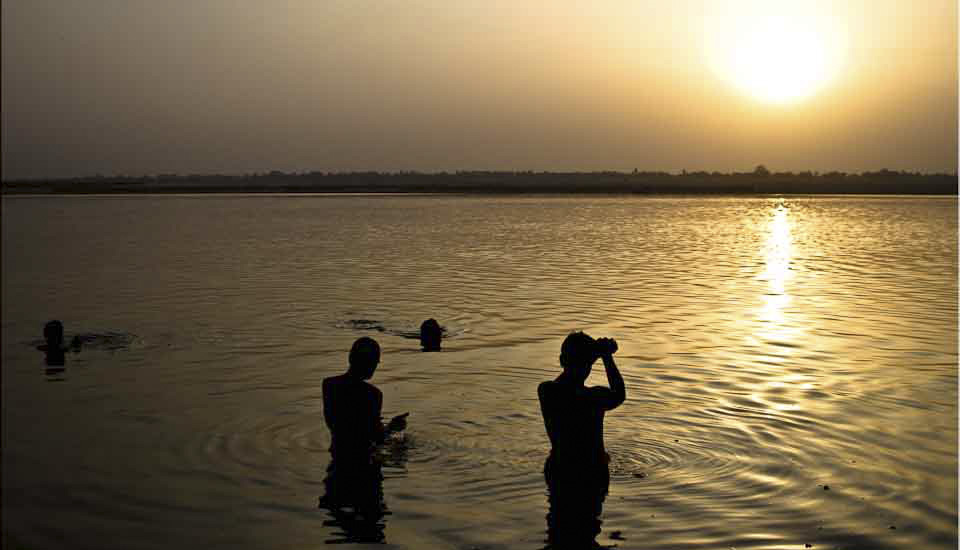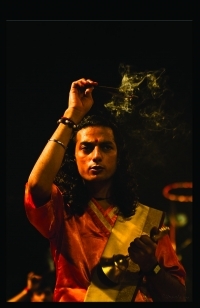.jpg)
Himba Woman
A smiling Himba woman welcomes us into a small, dark hut.
Family.
A word that entered into English in the early 1400s, meaning “servants of a household,” from the Latin familia “family servants, domestics collectively, the servants in a household.” The original definition includes the estate, the property; the staff, and any relatives.
How things change!
When I was growing up, “family” generally meant a nuclear family of two parents and their children, with an “extended family” of grandparents, aunts, uncles and cousins. How this “family” was expected to look was pretty narrowly based on the models provided by 1950s-60s American television or Norman Rockwell paintings. For most “average” households, servants were nowhere in sight.
Of course, in an abstract way, we knew that “families” looked different in various times and places, but that which is “familiar” is that which we are comfortable with.
It continually surprises me how we confuse that which is “familiar” with that which is “correct”, or worse: that which is “normal”. Standing in one’s own skin, it can be difficult or uncomfortable to acknowledge how disparate models of relationships might work well for those participants within them.
Of course, it is a fine line. “Normal” relationship models can fulfil a socio-political function – usually serving to protect the status-quo and to protect the interests of those in positions of power. But, as we have seen with the colonisation of indigenous communities all over the world, dismantling old relationship structures is more likely to lead to a disenfranchised underclass than to an empowerment of those individuals from traditional communities.
With these thoughts (and similar) in mind, I was fascinated to spend some time – thanks to photographer Ben McRae and local Namibian guide Morne Griffiths – with a group of OvaHimba (Himba) people.
Staying near the magnificent Epupa Falls in northwestern Namibia is an extraordinary experience. Not only is the landscape other-worldly (see: Landscapes of the Kunene and In Search of Crocodiles), but the local communities are fascinating!
Dotted either side of the Kunene River – which separates northwestern Namibia from its neighbour: Angola – are small compounds of wattle-and-daub huts surrounded by rough-hewn fences. Called onganda, each of these homesteads include huts and work shelters for a single extended family of semi-nomadic Himba tribal people.
The Himba have maintained a traditional lifestyle that has changed little since the early 1500s. Their expectations of how “families” are organised deviates greatly from what is “familiar” to me. Although their tribal structure is based on bilateral descent; that is, all Himba belong to two clans: their father’s and their mother’s, young women clearly have less say in their own futures than the elder men. Himba are polygamous, with the average man having two or three wives. Marriages – first marriages, at least – are arranged by the father, with girls sometimes being promised from infancy. As far as I could establish, young men are in their early thirties before getting married, but young women are married off at puberty.
The Himba worship their ancestors and the god Mukuru. The small family-village homesteads are generally overseen by a headman, who is usually the oldest male. He is responsible for maintaining the residence; looking after the religious aspects of life – which include the okuruwo (sacred ancestral fire) and a central enclosure (kraal) for the sacred livestock; and for ensuring that the traditional rules and the specific mandates of the clan are followed, allowing the “proper relations between human and ancestor”. Because the god Mukuru is distant, and often busy, the ancestors act as his representatives in the onganda.
The women of the family/village are responsible for movable property and handling any money. They also do much of the practical daily work. Each wife within the commune usually has her own hut, and during the dry season, when the household might be split between the main compound and the cattle post, one or more wives will stay behind in the onganda.
Although girls have little or no say in their first marriages, fidelity is not expected: extra-marital affairs and children out-of-wedlock are apparently common. Women can leave a marriage if they wish – at which point they return to the homestead of their birth. It is also common for women to travel to visit relatives in other compounds.
So, with the relationship complexities and the lack of a common language, I had difficulty ascertaining who was related to whom in the little village of Otjomazeva in the Kunene region of Northern Namibia.
.jpg)
Our Himba Guide
Local Himba man, Tom, is our guide in the Kunene region. His smile shows the filed gap in his front teeth that the tribe are known for. He welcomes us to the small onganda – or extended family homestead – of Otjomazeva.
.jpg)
Tom in the Kraal
In the middle of the kraal, there is an okuruwo (a sacred ancestral fire) which is carefully kept burning at all times. There is also a central enclosure for sacred livestock, which represents the ”proper relations between the ancestors and humans.”

Watchful Eyes
There are a lot people in the onganda. Some of them are visitors from other extended family homesteads in the region.

Old Woman
Himba people traditionally wear a lot of necklaces and bracelets. Made from a variety of materials – including shells, seeds, bone, leather, metal fencing wire, and other found materials – some of the jewellery is very heavy. This woman is not wearing her sculptured sheepskin Erembe headpiece; she may be widowed or less involved in the community decision-making, or may just be taking a break.

Man in the Kraal
Himba men often wear Western clothing, but pair it with traditional jewellery. Like many Himba – men and women – this man is wearing a heavy torque necklace as part of his outfit.

Newliweds
Himba men keep their hair covered from the time they are married. As far as I could discern, his marriage was recent, and he was very excited about being photographed with his young wife.

Young Bride

Himba Elder
In the heat of the afternoon, the older Himba men return to the village …

Man and a Hut
… and find a patch of shade to sit in.

Mother Selling Trinkets
Late in the afternoon, the women and girls in the village lay out trinkets for sale to tourists who come to visit the village.

Himba Baby
This young baby alternates between watching her mother …

Himba Baby
… and amusing herself.

Stillness and Chat

Old Aunties
Two elder women, visiting relatives from across the Kunene River in Angola, keep watch over the proceedings in the kraal.

Preparing Gruel
Twice a day, women prepare boiling water for the staple porridge made from mahangu (pearl millet) or maize – …

“Mind your Skirts – Mind the Baby”
… being careful of their leather skirts and their young charges.

Child-with-a-Child
As the shadows lengthen over the village, it is time for us to leave for the night.

Old Auntie Smoking
The next morning we returned to the village …

Young Woman’s Smile
… and we join the women in a dark hut for their morning beauty ritual.

Young Father
When the women have finished their morning beauty routine, the handsome husband of one of the visiting women joins us in the hut.

Boy-Child
A young boy leans in the doorway of the dark Himba hut. Males do not wear the ochre paste that the women use, so his skin tones are natural.

Making Morning Tea
Outside the huts, a young Himba woman boils water for morning tea. Her toddler helps, putting things in the fire.

Young Boy
A youth – who is in worn western clothing – stands next to a daubed hut.

Putting out Trinkets
Another youth shows one of the toddlers how to lay out the trinkets for the expected tourists.

Siopis and her Man
The Himba are a graceful people, and used to being photographed; they fall into poses without being asked!

Carrying a Loaded Bundle
The balance and elegance of native women always amazes me.

Old Aunties in the Truck
When we leave the village, we give a number of women a lift to town, where they hope to hitch a ride back to Angola.
We drop our Himba passengers under a tree in the small hamlet of Epupa. We pack up our campsite in preparation for moving on in Namibia, while they sit and gossip and wait for transport back to Angola in the mid-day heat.
 It truly is an unfamiliar world.
It truly is an unfamiliar world.
Until next week,
Happy Travels!
Pictures: 16-17August2015



.jpg)






























.png)


You have a beautiful blog.
I can see the innocence and simplicity of the nomads here.The picture of the child with the baby is priceless.Cheers.
Thanks very much, Sidran! 😀
Amazing post! Gorgeous photos and fascinating subject. thanks!
Many thanks, Susan!
I’m happy to have your visit. 😀